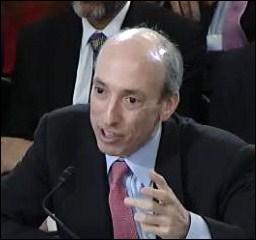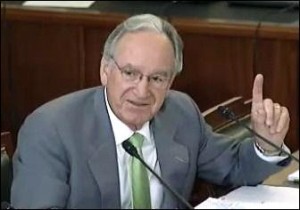By Pam Martens: July 18, 2012

Gary Gensler, Chair of the Commodity Futures Trading Commission, Tells the Senate Agriculture Committee On July 17, 2012 That the U.S. Justice Department Has Had the Libor Case Since 2010; His Own Office Has Had the Case Since April 2008. No Charges Have Been Brought Against Any U.S. Bank.
With so much press attention going to the transatlantic finger pointing by Washington and London, it’s easy to lose sight of the depth of the Libor scandal and what it means to the pocketbooks of average workaday folks here in the U.S. and around the globe. It’s also easy to overlook that we’re also talking about what the public has long suspected: that proprietary trading, where big banks and Wall Street firms trade for the house, is corrupt to its core.
Libor is an interest rate index that impacts the family budget in significant ways. It controls approximately $10 trillion in consumer loans around the globe, including adjustable rate mortgages, credit cards and student loans here in the U.S. According to emails obtained by prosecutors, in some cases prior to 2007, Libor was rigged higher, which would have caused higher interest rates on consumer loans tied to Libor.
Libor is also the index used to establish cash payments on interest rate swaps sold to our state, county, and city municipal governments and school districts across America and around the globe. According to prosecutors, from at least the financial crisis in 2008 and years thereafter, Libor was rigged lower. This caused municipalities and schools to receive many billions less than they should have in interest payments. That may have forced unnecessary layoffs, school closings, and cutbacks in public services. It may have also forced municipalities to raise property taxes or other taxes to compensate for the shortfall.
Libor is overseen by the British Bankers Association in London. A Libor interest rate is produced for ten currencies over 15 maturity periods from overnight to one year. Every morning, 8 to 16 banks, depending on the currency, submit rates based on this official gauge: “At what rate could you borrow funds, were you to do so by asking for and then accepting inter-bank offers in a reasonable market size just prior to 11:00 a.m. (London time)?” Once rates are submitted, the highest 25 percent and lowest 25 percent are discarded and the remaining submissions are averaged. The final calculations are released each day at about 11:30 a.m.
One of the questions that Congressional hearings need to address is why the American consumer’s financial welfare is based on an interest rate index they’ve never heard of, set on the other side of the Atlantic Ocean and overseen by a decidedly biased trade association, the British Bankers Association.

Senator Tom Harkin of Iowa Tells Fellow Members of the Senate Agriculture Committee on July 17, 2012 That He Has Lost Confidence in Self Regulation of Financial Markets
The opportunity to illegally profit by rigging Libor is mammoth. According to the key regulator for futures and derivatives here in the U.S., the Commodity Futures Trading Commission (CFTC), “…approximately $350 trillion of notional swaps and $10 trillion of loans are indexed to LIBOR. LIBOR also is the basis for settlement of interest rate futures and options contracts on many of the world’s major futures and options exchanges, including the three-month and one month Eurodollar contracts on the Chicago Mercantile Exchange (CME). The total traded volume of the CME Eurodollar contract had a notional value of over $437 trillion in 2009 and $564 trillion in 2011.”
If a traders knows, or suspects, where Libor is to be set, he can make enormous trading profits for the proprietary trading desk (the desk that bets for the house) at big Wall Street firms and other global banks.
And here is a small sampling of the email evidence that prosecutors have released so far, showing that making profits for the house was at the core of this rigged game. The emails below were coming from traders on the proprietary desks of the firms who were supposed to be behind the so-called Chinese Wall, barred from knowing or instructing on what Libor rates would be submitted by other bank personnel. (The small “m” in the emails means “month.”)
“WE HAVE TO GET KICKED OUT OF THE FIXINGS TOMORROW!! We need a 4.17 fix in 1m (low fix) We need a 4.41 fix in 3m (high fix)” (November 22, 2005, Senior Trader in New York to Trader in London);
“You need to take a close look at the reset ladder. We need 3M to stay low for the next 3 sets and then I think that we will be completely out of our 3M position. Then its on. [Submitter] has to go crazy with raising 3M Libor.” (February 1, 2006, Trader in New York to Trader in London);
“Your annoying colleague again … Would love to get a high 1m Also if poss a low 3m … if poss … thanks” (February 3, 2006, Trader in London to Submitter);
“This is the [book’s] risk. We need low 1M and 3M libor. PIs ask [submitter] to get 1M set to 82. That would help a lot” (March 27, 2006, Trader in New York to Trader in London);…
“Hi Guys, We got a big position in 3m libor for the next 3 days. Can we please keep the lib or fixing at 5.39 for the next few days. It would really help. We do not want it to fix any higher than that. Tks a lot.” (September 13, 2006, Senior Trader in New York to Submitter)…”
U.S. prosecutors have admitted that the goal of this rigging was to engage in insider trading for the proprietary desks of some of the largest banks in the world. But interestingly, you do not see any headlines using the words “insider trading” or “proprietary trading.”
The CFTC’s order against the only firm to be charged thus far, Barclays, reads in part:
“During the period from at least mid-2005 through the fall of 2007, and sporadically thereafter into 2009, Barclays based its LIBOR submissions for U.S. Dollar (and at limited times other currencies) on the requests of Barclays’ swaps traders, including former Barclays swaps traders, who were attempting to affect the official published LIBOR, in order to benefit Barclays’ derivatives trading positions; those positions included swaps and futures trading positions…These Barclays Euro swaps traders agreed to ask, and did ask, the Barclays submitters for rates that benefited the trading positions of the traders at the other banks…”
This was not just Libor rigging, this was an international banking cartel of insider traders. It makes the Republicans on the Senate Banking and House Financial Services committees, who are trying to restrict the so-called Volcker Rule against proprietary trading look like uninformed sycophants for Wall Street.
Two of America’s largest Wall Street banks are deeply implicated in the rigging, JPMorgan Chase and Citigroup. According to prosecutors in the Canadian Competition Bureau, in an affidavit submitted to the Ontario Superior Court, it “became aware of this matter after one of the Participant Banks in the Alleged Offences (the ‘Cooperating Party’) approached the Bureau pursuant to the Immunity Program.” That unnamed party continues to cooperate with the authorities in Canada.
According to the prosecutors’ affidavit, a trader working for the whistleblowing firm “had communications with two IRD [interest rate derivatives] traders at JPMorgan regarding its Yen Libor submissions. Trader A communicated his trading positions, his desire for a certain movement in Yen Libor and gave instructions for them to get JPMorgan to make Yen Libor submissions consistent with his wishes. Trader A also asked if the IRD traders at JPMorgan required certain Yen Libor submissions to aid their trading positions. The JPMorgan IRD traders acknowledged these requests and said they would act on them. On another occasion one of the JPMorgan IRD traders asked Trader A for a certain Yen Libor submission, which Trader A agreed to help with. Trader A admitted to an IRD Trader at RBS that he colluded with IRD traders at JPMorgan.” The affidavit provides two names of traders at JPMorgan that prosecutors believe were involved in the scam.
Similar allegations are listed for Citigroup/Citibank but the trader is not named. It does say, however, that he is believed to have previously worked for the whistleblowing bank.
Canadian prosecutors have also made it clear that they are looking at far more than just rigging the Libor index. The affidavit states they are investigating whether the banks “conspired to prevent or lessen, unduly, competition in the purchase, sale, or supply of interest rate derivatives from 2007 to March 11, 2010…”
The other banks being investigated by Canadian authorities are HSBC, Royal Bank of Scotland Group (RBS), Deutsche Bank AG, and two cash brokers, ICAP Plc and RP Martin Holdings Limited. Canadian prosecutors have placed some information under seal with the court, including the name of the cooperating bank. The affidavit calls the allegations an international conspiracy.
The court affidavit is signed by Brian Elliott, a lawyer in the Canadian Competition Bureau. Elliott has a law degree from the University of British Columbia with a Bachelor of Arts Honors degree from the University of Saskatchewan with a major in economics. He also holds a Bachelor of Commerce degree from the University of Saskatchewan with a major in finance, including coursework in derivative securities and international finance. That might explain why the Canadian prosecutors have moved much more rapidly than the U.S. Department of Justice.
According to testimony yesterday by Gary Gensler, Chair of the CFTC, before the Senate Agriculture Committee, the U.S. Department of Justice opened their case in 2010. Gensler said the CFTC opened their case in April 2008. To date, no U.S. firm or employee of any U.S. firm has been charged with regard to Libor.

